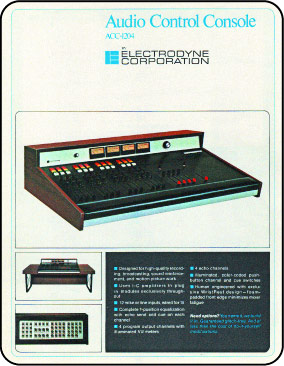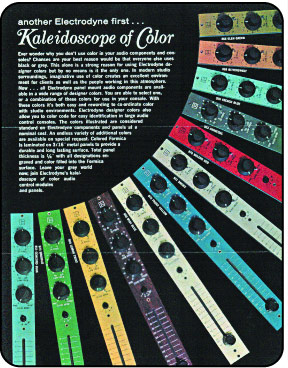 I’m
going to let you in on a little secret - one that few engineers
talk about and several will want to kill me for writing about.
What if I told you there was a microphone preamp that could rival
a Neve, Focusrite or API, have similar EQ as the venerable Pultec
and could be found for one-tenth the cost of same units?
Sound unbelievable? I’m talking about the Electrodyne,
Sphere and early Quad-Eight modules. I’m
going to let you in on a little secret - one that few engineers
talk about and several will want to kill me for writing about.
What if I told you there was a microphone preamp that could rival
a Neve, Focusrite or API, have similar EQ as the venerable Pultec
and could be found for one-tenth the cost of same units?
Sound unbelievable? I’m talking about the Electrodyne,
Sphere and early Quad-Eight modules.
Back in the late ‘40s and early 50's, the
first incarnation of Electrodyne was a manufacturer of
tube-based audio modules (preamps, line amps) for the film and
broadcast industry. In the ‘60s, as its later
incarnation, it would go on to help pioneer the console
industry as we know it. Throughout the ‘60s Quad-Eight
was a sales company that had Control, thus many of the early
Quad-Eight consoles have Electrodyne stamped on the components
inside. both Electrodyne and Quad-Eight consoles were
ordered by the likes of 20th Century Fox, Universal, Lions
Gate Films and others, but they were not limited just to film
companies. Decca Records, Warner Brothers, Motown (which
according to Motown mastering engineer at the time, Bob
Ohlsson, “had the first VCAs in it, possibly making it the
first automated console”) and Stax (as soon in Tape Op
#44) featured consoles, as well did live venues such as The
Hollywood Bowl, The Mormon Tabernacle and The Grand Ole Opry.
Back in the day there just weren’t many companies building
recording consoles. Electrodyne was the first to bring
many new concepts to console design that we take for granted
today, like a padded arm rest (!) and features like putting
the preamp, line amp, equalizer, send and returns and
attenuator into one nice little “input module: as they like to
call it, which of course could be plugged into a larger frame
and routed to a mono, stereo or even multitrack recorder.
Sound familiar?
I first learned of Quad-Eight through Danny
McKinney at Requisite Audio. Danny happened to have four of
the “bittersweet” color modules left from one of the early Warner
Brothers’ film consoles on his bench. He hadn’t used them in
years and reluctantly agreed to sell them to me. Once I got
them harnessed and powered up I did a set of listening tests
between them and my Neve BCM10s (with 1073 modules). Not
expecting much, I was very surprised when not only did they hold
up to these classics, but to my ear were in some ways better.
I couldn’t help but feel that these modules sat somewhere in
between the sound of a Neve and an API, with all the big boldness
and forward presence of the Neve (but lacking the extended top end
and compressed sound of a 1073) with a midrange clarity similar to
an API. Danny, as well as several other well-known
engineers, had been telling me to look at the Quad-Eights for
years, but because I had not ready much about them and couldn’t
find info on them I had passed on purchasing them time and time
again.
Wanting to investigate this phenomenon further I gathered a
group of musicians, engineers and producers together at Syborg
Studio to do an impromptu comparison of the Quad-Eights and some
early Electrodyne modules that I collected. I chose Syborg
for its excellent monitoring system and because owner Scott Benson
happens to own just about every other mic pre available to compare
them with. The units we used were manufactured by Neve
(1073, 1079 and 1081 modules), API (512s), Mastering Labs, Demeter
VTMP2, Manley and Summit (tube mic pres) and Focusrite (ISA110 and
115 modules). Along with Scott was master B3 player, Tony
Perrino (Great Southers, Toler Brothers Band), Jeff Britton
(recording and Electronic Engineer for Encore Electronics), Frank
Moscowitz ( Mumble Sound, Nevessa Studios) and producer/world
music and jazz great instrumentalist Carl Landa.
Time and time again we all agreed that on a variety of
sources (drum, human voice, acoustic and electric guitar,
B3/Leslie and triangle) the Quads and the Electrodynes held up
against the stiff competition. In some cases we favored
the sound of these pres over the others. Once we started
using the EQ section the power of these units became even more
evident. The passive inductor based EQ design with op amp
makeup gain allowed minimal phase shift into the material while
retaining full musicality of the select bands. The bands
are very limited by today’s standard, covering frequencies of
50, 100, 300 Hz on the low banks and high of 1.5, 3, 5 and 10
kHz on the Electrodyne 710 modules with the addition of mid
frequencies at 300, 500, 700, 1.5 kHz on the 711 module.
Not surprising is that the Quad-Eight MM310 with its ‘lo’ of 50,
140, 250, 400 Hz, ‘mid’ of 400, 700 Hz and 1.5, 3 kHz, and ‘hi’
of 3, 5, 7.5, 10 kHz have similar frequency points as the
Electrodyne units with the Q8 311 and 312 adding just a few
more. The chosen frequencies provide just the right amount
of musical muscle when needed - probably the reason these
frequencies points have become ‘standard’ over the years.
All boost (+10 dB) and cut 9-12 dB) switches have detented knobs
in 2 dB increments, making repeatability effortless and for
devices over thirty years old, they feel every bit as tactile as
if they were made yesterday. These things are build like a
tank. The higher the boost or cut, the narrower the band
becomes, just like a Pultec. Surgical? No.
Musical? Yes.
 One
set, the Electrodyne 712 modules, stood out in particular with
its graphic EQ section reminiscent of the highly regarded API
560s. These are the rarest of the modules and predate the
APIs by some years. I think it is safe to say that these
were the very first “console based” graphic EQs. With
frequencies covering 50, 100, 200, 400, 800 Hz and 1.6, 3.2, 6.4
and 12.8 kHz these graphics were definitely my favorites in the
group. Their power became very evident when used several
weeks later on a recording session to correct the frequency
response of a very lame Takamine acoustic guitar. Several
of the engineers had recorded this particular guitar in the past
with unsatisfactory results, culminating in the replacement of
the guitar on the tracks. They were even more surprised
when this lame guitar became a monster with the additions of
just a few bands on the 712. A useful and great sounding
tool at an incredible price. I had to learn more. One
set, the Electrodyne 712 modules, stood out in particular with
its graphic EQ section reminiscent of the highly regarded API
560s. These are the rarest of the modules and predate the
APIs by some years. I think it is safe to say that these
were the very first “console based” graphic EQs. With
frequencies covering 50, 100, 200, 400, 800 Hz and 1.6, 3.2, 6.4
and 12.8 kHz these graphics were definitely my favorites in the
group. Their power became very evident when used several
weeks later on a recording session to correct the frequency
response of a very lame Takamine acoustic guitar. Several
of the engineers had recorded this particular guitar in the past
with unsatisfactory results, culminating in the replacement of
the guitar on the tracks. They were even more surprised
when this lame guitar became a monster with the additions of
just a few bands on the 712. A useful and great sounding
tool at an incredible price. I had to learn more.
Reprinted with the permission of
Larry DeVivo. (Silvertone Mastering) and
TapeOp (The Creative Music Recording Magazine)
Copyright Larry DeVivo and TapeOp 2005. |